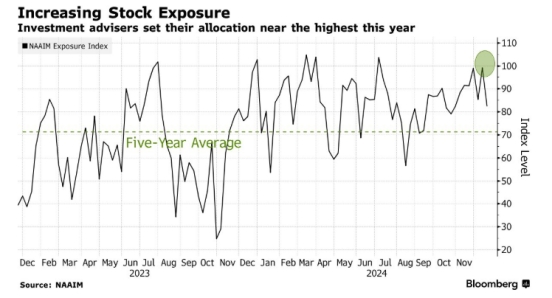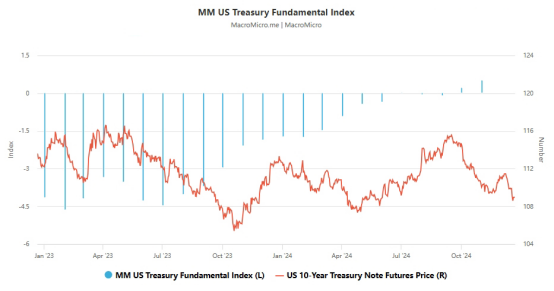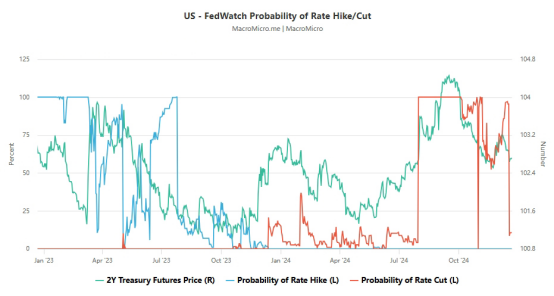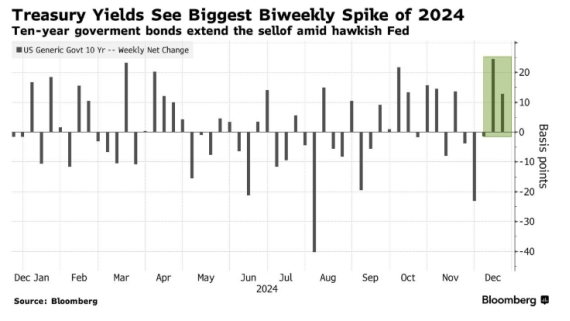The Fed turns to the "Trump deal" - the outlook for gold and the dollar amid market volatility
- 2025年1月2日
- Posted by: Macro Global Markets
- Category: News

A month ago, the hot topics in the market focused on Trump and his US economic blueprint to promote economic growth next year and in the future. However, as the Christmas holiday approaches, Federal Reserve Chairman Powell's hawkish turn has once again become the focus of the market, bringing the issue of inflation back into investors' attention and triggering the biggest market turmoil since Election Day.
Powell signaled a slower pace of rate cuts, leading to the worst performance in months for stock and bond markets. Two days later, market sentiment improved significantly after the Fed's preferred inflation gauge showed prices rose less than expected, spurring a cross-asset rally that helped the S&P 500 erase some of its weekly losses. Fueling the extreme market volatility is crowded positioning, much of it by investors betting that a Trump deal will further stimulate risk assets. Allocations to U.S. stocks jumped to record levels, while cash holdings disappeared, according to Bank of America's Global Fund Manager Survey.
With exposure to U.S. stocks jumping to record levels, the moves are a reminder that while it was Trump who sent speculation soaring, the trajectory of inflation and Powell's response to it remains difficult for markets where valuation measures have been pushed to extreme levels. Equally important. Benchmark U.S. stock indexes were still down about 2% for the week, while post-election stalwarts such as small-cap and value stocks fell for a third straight week.
“Investors thought the Fed was going to cut rates anyway,” said Samir Samana, senior global market strategist at Wells Fargo Investment Institute. “What’s disappointing is that the Fed finally woke up to the fact that inflation has stopped falling.” For now, the final fallout from Trump’s trade is the last thing many investors wanted: rising bond yields. The 10-year Treasury yield jumped to its highest level in seven months, driven by a reduction in bets on a rate cut after the Fed meeting.

Last week, the Federal Reserve finally confirmed the long-awaited "pivot" by the market, and the central bank's statement this week and update to its economic forecasts had a huge impact on the market. Market participants currently expect the Fed to cut interest rates by about 40 basis points by December 2025, and U.S. Treasury yields rose in response. The impact spread across markets, and the U.S. stock market experienced its worst day since August. The Volatility Index (VIX) experienced the second largest single-day jump in history as the market tried to digest the Fed's outlook.
Earlier, global stock markets saw similar declines until US personal consumption expenditures (PCE) data provided some respite. While PCE remained strong, the increase was lower than expected, which helped to alleviate some of the selling pressure on US stocks. Similar trends were seen in foreign exchange markets, with the US dollar generally strengthening and breaking through the 108 mark at one point. Gold prices briefly fell below $2,600 per ounce, but also rebounded back above that level on Friday. The crude oil market continues to feel the pressure of concerns about demand growth, and given the changes in expectations for rate cuts in 2025, the market is more worried that this will continue to affect future demand.

Markets will be relatively quiet next week due to Christmas, although there are still some relatively influential data, but market volatility may become large due to thin liquidity. The Federal Reserve has just concluded its last policy decision in 2024, and market optimism is scarce. Officials predict only two rate cuts of 25 basis points each in 2025, leading market participants to expect the Fed to cut interest rates less than any other major central bank in the next 12 months, with the exception of the Bank of Japan (which is raising interest rates).
While this was not entirely unexpected, especially after Trump's unexpected landslide victory in the US presidential election, the Fed's hawkish stance caught the market off guard. Fed Chairman Jerome Powell strongly hinted in his post-meeting press conference that officials are already considering the impact Trump's policies may have on the economy and inflation. This reality check from the Fed dampened market sentiment and unsettled investors before the Christmas holiday, and some analysts even expected that if the incoming Trump administration does not water down its campaign promises on taxes, tariffs and immigration, the rate cuts may even turn into rate hikes.

Gold has fallen sharply over the past week amid rising U.S. Treasury yields and the dollar. If the 10-year Treasury yield continues to remain above 4.50%, gold will struggle to hold the $2,600 level and seems likely to test support at $2,530 again. Many analysts expect gold prices to reach $3,000 an ounce next year, but the metal is not expected to rise until the second half of 2025. Meanwhile, with gold prices consolidating around $2,650 an ounce, next year's target would be about 13% higher than this year's nearly 30% gain. In his outlook note, the commodity analyst at the second-largest U.S. bank said gold faces significant resistance, in part because Western investors will have to deal with potentially higher bond yields and a stronger dollar.
The Trump administration is likely to pursue a policy mix that will likely limit investors' appetite for increased gold purchases in the near term through stronger growth, higher inflation, higher interest rates, and a stronger dollar. For the dollar, with the overall hawkish bias within the Fed, it is not expected to easily lose the throne it has gained this year, although low trading volumes during the holiday season could trigger some unwanted volatility. Overall, if there is any market turmoil during the holiday season, it is more likely to hit U.S. stocks and bonds. The Fed's hawkish stance has not been well received by Wall Street, and the sell-off could intensify as U.S. Treasury yields continue to climb. The U.S. Treasury is scheduled to auction two-year, five-year, and seven-year Treasury notes on Monday, Tuesday, and Thursday, respectively, which could add to the upward pressure on yields if demand is sluggish.
